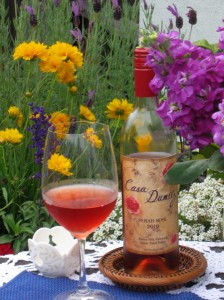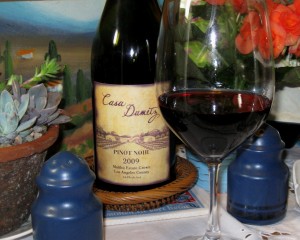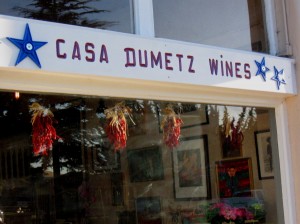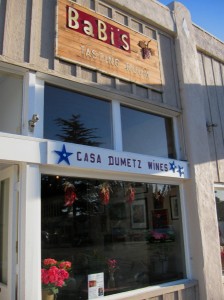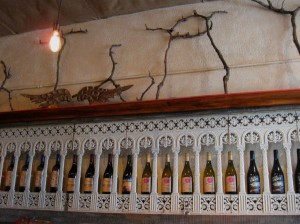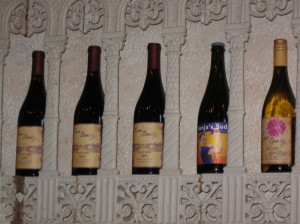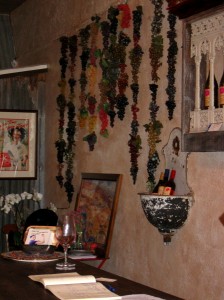Jun 20 2012
Learning, Living & Loving: a Visit with Casa Dumetz
For anyone who has grown grapes, made wine or for any length of time simply lived adjacent to the wine industry, the heart and the base of winemaking is agriculture. Our culture for generations has associated wine consumption with finery, celebration and at times, elitism. But at the end of the day, the grapes that make the wine that you drink come from one common source around the world: the land.
Similarly, if you garden, grow produce or grow grapes, you realize that not only is the land integral to your bounty but you become keenly aware that your interaction with the land affects its productivity for you, your neighbors, your community and for countless generations beyond. What you put into the soil affects its chemistry and quality (not always for the better) and what you grow may cross-pollinate with your neighbor’s attempts. You may attract helpful insects or you may attract harmful pests.
When you begin to not just understand but comprehend this cycle, you realize the honor of working within a much greater system and contributing to its balance. Regardless of whether your experience is failure or success, there is bountiful knowledge to be learned and time is your greatest asset as the educational process is seemingly endless.
It is no surprise then that winemaking is a much bigger process than growing grapes, putting juice in a bottle and releasing a delicious wine. When looking at smaller family-owned wineries, the consumer has a unique opportunity to get closer to the winery’s process. From simple observation and often visiting tasting rooms, the consumer can witness the winery’s culture and how it does its own dance in conjunction with the land that delivers the grapes that the winery needs for its own commercial existence.
Over the past year and a half, I have had the opportunity to explore the wines that Casa Dumetz Winery (“Casa Dumetz”) has been releasing. During this time, its wine portfolio has more than doubled and the horizon yields endless possibilities for winemaker Sonja Magdevski and her fiancé, Emilio Estevez. While Emilio and Sonja grow their own estate Pinot Noir grapes in Malibu (located in Los Angeles County), the majority of their grapes are sourced from the Santa Ynez Valley (more specifically, through a special relationship with the Tierra Alta Vineyard), in Santa Barbara County. With its rapid success and growth, Casa Dumetz decided to open a tasting room to the public on December 2, 2011.
While it would have been simpler to mention the tasting room in a prior article featuring the wines and food pairings that I create, I frankly wanted to visit the tasting room myself first. The desire to visit the tasting room was largely motivated by my own observations, understanding and knowledge of Sonja’s winemaking operations and zest for life. For example, she and Emilio are firmly committed to growing their own produce. Raised bed gardens adorn their lawn, grape vines dress the property and produce abounds such that they are living their lives seasonally, sustainably and in harmony with the land. When such a commitment is readily apparent in their own personal lives, it is a good hunch that their tasting room will deliver an equally clear message.
The tasting room for Casa Dumetz is not located near Malibu but instead farther north up Highway 101 in historic Los Alamos, in Santa Barbara County, California. Upon reading the location choice, the casual visitor may be puzzled. However, the reason for the choice is abundantly clear. First, Santa Barbara County is where the majority of the grapes are grown for Casa Dumetz’ wines. Spending time in closer proximity to the actual vineyard and the grapes allows the winemaker (Sonja) to have a greater understanding of what is happening regularly with the weather, which directly influences the acidity, sugar and alcohol level in the grapes for a particular vintage. This helps Sonja continue to learn and grow with her winemaking even though the Tierra Alta vineyard is managed by John Belfy of Buona Terra Farming. Second, once you exit off Highway 101 for Los Alamos and make your way past vineyards to the historic town’s main street, it becomes visually and sensually clear why Sonja chose this location.
The feel of artisanry is in the air. Your car naturally slows so as to not miss anything in this tiny historic California town. For those who are originally from California, you instantly recognize that Los Alamos is still a tiny slice of true California culture and representative of how California culture was decades (if not generations) ago.
Artisanry is important to Sonja and it is clearly reflected in the care and quality of her winemaking. Her tasting room also represents her commitment to artisanry. She has said,
“I romanticize a time in our country and world when every corner of it had its own regional foods, drinks, music and culture that defined who the people were and where they came from. Our wine is like that and as much as possible we try and do live like that. I want the tasting room to be a reflection of other people locally producing interesting art: whether it is jewelry, or the handmade wine boxes with fresh cedar shavings. All of this is important because it is not only an expression of where that person lives locally but also where that person has been and the stories they listened to and learned along the way. Local artists have an integrity that I appreciate.”
Another similar benefit of local artisanry is that it folds integrally into a place’s local culture and transcends through its residents. The people are friendly in Los Alamos. It is not uncommon to hop out of your car and have a stranger smile and say “hello”. People are willing to answer questions, help you and more importantly welcome you into their community. Sonja similarly found this when she decided to locate her tasting room on Los Alamos’ main street. Similarly, when I visited their tasting room alone, I had no problem integrating into conversations with other people. I chose to stop by an hour before the room was scheduled to close and yet suddenly a wave of ten to fifteen people stopped in to taste wine, have a glass, chat and share their experiences from the day. Within minutes, I did not feel “alone” but instead felt like I was part of a community and more importantly, welcomed with a sense of belonging.
This cultural sense of generosity and embrace ties intimately to Casa Dumetz’ tasting room as it has been opened under the name “Babi’s Tasting Room” in honor of Sonja’s late grandmother. “Babi” means grandmother in Macedonian (which is Sonja’s heritage). According to Sonja,
“She [Babi] was a woman who lived life on her own terms. She understood life and its complexities with an acuteness that few people possess. She was not flawless. She gave her heart and soul to everyone. She forgave everyone. And, most importantly, she truly enjoyed sharing a glass of wine or homemade whiskey with friends and family, along with the delicious food she always made. She taught me to let go and enjoy the moment, an art form which I still haven’t mastered.”
The décor of the tasting room offers plenty to study and contemplate. It is clear that thought and effort went into designing the space and further ensuring that the ambiance is warm and welcoming. There is ample seating, which varies from stools at a long tasting bar, to small tables and chairs for gathering and comfortable plush seating along the outer edges of the room. Everywhere you turn there is something to study and uniquely, something or someone from which to learn.
While I was in the tasting room, a young woman entered and called out that she was returning a book. As it turns out, Sonja has uniquely included a “lending library” of books. These books can vary in topics from winemaking, Macedonian textiles, growing your own produce to straw bale homes. Again, reflecting a commitment to artisanry but instead firmly encouraging learning. Sonja personally loves to learn and claims that she is notorious for asking a never-ending litany of questions. She claims that Emilio from time to time has to nudge her in order to cue her to slow her questions for fear that the recipient may feel interrogated.
Realizing that most visitors do not intend to sit down and read a book while exploring their wines, Sonja encourages visitors to borrow books (or contribute some of their own) from the lending library. When the book is returned, Sonja presently extends a ten percent discount off of your wine purchases. Your purchases of course leave the winery in a handmade burlap bag which fits with Sonja’s commitment to environmental sustainability and the culture of Los Alamos.
If you happen to plan to return your book on a Friday evening to the tasting room and have called in advance to reserve a seat, you are in for an even greater treat. Sonja has uniquely started a Friday night lecture series aptly titled, “Words to Live By”. Purchase a glass of wine or a bottle to share with friends, sit back, listen and learn about topics ranging from art, gardening, vintning, sustainable living and farming, among others.
Perhaps the best educational treat of all is that Sonja herself is in the tasting room most days. Sonja states that local artists by nature have to work and interact with their customers directly. Sonja also presently mans the tasting bar, interacts with her patrons face to face and learns by extension of this interaction. She maintains her own artisanal integrity as a result and the patron gets the very unique opportunity to interact with the actual winemaker. Since Sonja is such an enthusiastic interrogator, rest assured that she is an equally welcoming recipient of questions, too.
It is easy to feel like you are part of something when visiting Casa Dumetz’ tasting room. Your mind and your own horizons expand right alongside Casa Dumetz. Do not be mistaken, however, your presence is also adding to the mix. You are bringing your stories, your experiences and your journey to the mix. The people who surround you are equally curious and learn from you. The greater joy is the intuitive sense that you are also contributing to something with greater cultural meaning in this tiny historic Californian town.
*Casa Dumetz Wines’ “Babi’s Tasting Room” is open to the public on Thursdays 12 p.m. to 7 p.m., Friday and Saturday 11 a.m. to 7 p.m. and Sunday 11 a.m. to 6 p.m. and located at 448 Bell Street, Los Alamos, California. (Monday, Tuesday and Wednesday the tasting room is open by appointment only).
Comments Off on Learning, Living & Loving: a Visit with Casa Dumetz

